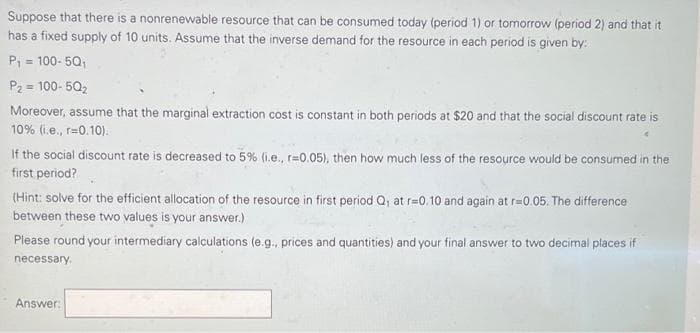resource that can be consumed today (period 1) or tomorrow (period 2) and that it has a fixed supply of 10 units. Assume that the inverse demand for the resource in each period is given by: P = 100- 5Q, P2 = 100- 50, Moreover, assume that the marginal extraction cost is constant in both periods at $20 and that the social discount rate is 10% (.e., r#0.10). If the social discount rate is decreased to 5% (i.e., r-0.05), then how much less of the resource would be consumed in the first period? (Hint: solve for the efficient allocation of the resource in first period Q, at r-0.10 and again at r-0.05. The difference between these two values is your answer.) Please round your intermediary calculations (e.g., prices and quantities) and your final answer to two decimal places if necessary. Answer:
resource that can be consumed today (period 1) or tomorrow (period 2) and that it has a fixed supply of 10 units. Assume that the inverse demand for the resource in each period is given by: P = 100- 5Q, P2 = 100- 50, Moreover, assume that the marginal extraction cost is constant in both periods at $20 and that the social discount rate is 10% (.e., r#0.10). If the social discount rate is decreased to 5% (i.e., r-0.05), then how much less of the resource would be consumed in the first period? (Hint: solve for the efficient allocation of the resource in first period Q, at r-0.10 and again at r-0.05. The difference between these two values is your answer.) Please round your intermediary calculations (e.g., prices and quantities) and your final answer to two decimal places if necessary. Answer:
Chapter1: Making Economics Decisions
Section: Chapter Questions
Problem 1QTC
Related questions
Question

Transcribed Image Text:Suppose that there is a nonrenewable resource that can be consumed today (period 1) or tomorrow (period 2) and that it
has a fixed supply of 10 units. Assume that the inverse demand for the resource in each period is given by:
P; = 100- 5Q;
P2 = 100- 50,
%3D
%3D
Moreover, assume that the marginal extraction cost is constant in both periods at $20 and that the social discount rate is
10% (i.e., r=0.10).
If the social discount rate is decreased to 5% (i.e., r=0.05), then how much less of the resource would be consumed in the
first period?
(Hint: solve for the efficient allocation of the resource in first period Q, at r=0.10 and again at r=0.05. The difference
between these two values is your answer.)
Piease round your intermediary calculations (e.g., prices and quantities) and your final answer to two decimal places if
necessary.
Answer:
Expert Solution
This question has been solved!
Explore an expertly crafted, step-by-step solution for a thorough understanding of key concepts.
Step by step
Solved in 2 steps with 2 images

Knowledge Booster
Learn more about
Need a deep-dive on the concept behind this application? Look no further. Learn more about this topic, economics and related others by exploring similar questions and additional content below.Recommended textbooks for you


Principles of Economics (12th Edition)
Economics
ISBN:
9780134078779
Author:
Karl E. Case, Ray C. Fair, Sharon E. Oster
Publisher:
PEARSON

Engineering Economy (17th Edition)
Economics
ISBN:
9780134870069
Author:
William G. Sullivan, Elin M. Wicks, C. Patrick Koelling
Publisher:
PEARSON


Principles of Economics (12th Edition)
Economics
ISBN:
9780134078779
Author:
Karl E. Case, Ray C. Fair, Sharon E. Oster
Publisher:
PEARSON

Engineering Economy (17th Edition)
Economics
ISBN:
9780134870069
Author:
William G. Sullivan, Elin M. Wicks, C. Patrick Koelling
Publisher:
PEARSON

Principles of Economics (MindTap Course List)
Economics
ISBN:
9781305585126
Author:
N. Gregory Mankiw
Publisher:
Cengage Learning

Managerial Economics: A Problem Solving Approach
Economics
ISBN:
9781337106665
Author:
Luke M. Froeb, Brian T. McCann, Michael R. Ward, Mike Shor
Publisher:
Cengage Learning

Managerial Economics & Business Strategy (Mcgraw-…
Economics
ISBN:
9781259290619
Author:
Michael Baye, Jeff Prince
Publisher:
McGraw-Hill Education